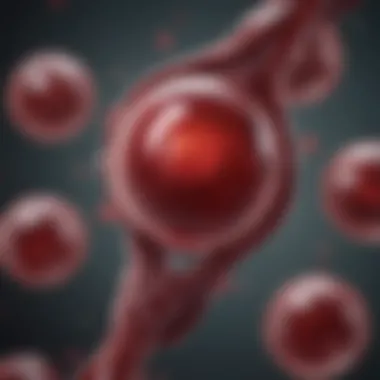Sickle Cell Anemia: Inheritance and Impacts


Intro
Sickle cell anemia is a genetic disorder that primarily affects the formation of hemoglobin. This article seeks to explore the inheritance patterns of this condition, while unpacking the complex mechanisms involved in its transmission. Understanding these mechanisms is crucial for families impacted by the disease and for researchers aiming to further investigate its implications.
Overview of Research Topic
Brief Background and Context
Sickle cell anemia arises due to a mutation in the HBB gene located on chromosome 11. This mutation transforms the normal hemoglobin into abnormal hemoglobin S. Individuals who inherit two copies of the gene (one from each parent) develop sickle cell anemia. Those who inherit only one copy of the mutated gene often remain asymptomatic carriers, referred to as having sickle cell trait. The disease is particularly prevalent among individuals of African, Mediterranean, and Middle Eastern descent, highlighting its significance in specific populations.
Importance in Current Scientific Landscape
The study of sickle cell anemia not only broadens our understanding of genetic inheritance but also contributes to the broader field of genetics and public health. With advancements in gene therapy and genetic counseling, understanding sickle cell's inheritance can empower affected families to make informed decisions regarding reproduction and management of the disorder. Furthermore, the implications of this research extend into broader genomic studies that provide insights into various genetic disorders.
Methodology
Research Design and Approach
To comprehensively analyze sickle cell anemia inheritance, a mixed methods approach is essential. This would involve quantitative analyses of genetic data, as well as qualitative research examining familial experiences with the condition. Such an approach ensures a more holistic understanding of the impact of sickle cell anemia across generations.
Data Collection Techniques
Data collection can involve several techniques:
- Genetic Testing: Analysis of blood samples to identify genotypes in affected individuals and their families.
- Surveys: Gathering information on family health history, treatments, and experiences with the disorder.
- Interviews: Conducting detailed discussions with families to gain insights into the psychosocial impact of the disease.
By employing these methods, researchers can collect valuable information about the patterns of inheritance and the lived experiences of those affected by sickle cell anemia.
"Understanding the hereditary patterns of sickle cell anemia is essential for effective treatment and management strategies for individuals and families."
These focused methods allow for targeted research, which can improve the quality of life for affected individuals and their families.
Preface to Sickle Cell Anemia
Sickle cell anemia, a genetic disorder, is significant both for individuals affected and for broader societal contexts. This introduction outlines its relevance, focusing on the disease’s genetic nature and its implications on health and inheritance. Understanding this condition is critical for families that may harbor the genetic trait and for healthcare providers who assist them. Knowledge about sickle cell anemia can empower individuals and communities to navigate challenges associated with the disorder.
Defining Sickle Cell Anemia
Sickle cell anemia arises from a mutation in the HBB gene, which encodes the beta-globing component of hemoglobin. This mutation modifies the structure of hemoglobin, resulting in red blood cells deforming into a sickle shape. Normal red blood cells are round and flexible, allowing them to move easily through blood vessels. In contrast, sickled cells can block the flow of blood and lead to severe complications.
The complications include pain crises, organ damage, and an overall reduced quality of life. Diagnosis typically occurs through blood tests that identify abnormal hemoglobin types. Effective management requires a robust understanding of the disease’s genetic basis and its inheritance patterns.
Historical Context
The history of sickle cell anemia is intertwined with its geographic and socio-economic narratives. First identified in the early 20th century, the sickle cell trait was found to provide a selective advantage against malaria. In regions where malaria is prevalent, individuals with the sickle cell trait are less likely to die from the disease, leading to a higher frequency of the trait in those populations.
Research into sickle cell anemia increased in the 1940s when scientists began to understand its genetic nature. This realization opened the door to modern genetic analysis, enabling families to determine the risks of passing the trait to offspring. Over the years, medical advancements have improved understanding, treatment, and support for affected individuals.
"Understanding the historical context of sickle cell anemia emphasizes the importance of genetic research and its real-world application in healthcare."
Genetic Basis of Sickle Cell Anemia


Understanding the genetic basis of sickle cell anemia is crucial for various reasons. First, it helps clarify how this disorder is inherited, impacting family planning and public health strategies. It contributes to knowledge about the mutation processes leading to the disease, arming researchers and clinicians with information that can guide treatment approaches. Moreover, elucidating this genetic foundation paves the way for advancements in gene therapy, improving outcomes for individuals affected by the condition.
Hemoglobin Structure and Function
Hemoglobin is a complex protein found in red blood cells, responsible for transporting oxygen from the lungs to the rest of the body. Normal hemoglobin, referred to as hemoglobin A (HbA), is composed of two alpha and two beta globin chains. This precise structure ensures efficient oxygen delivery. In sickle cell anemia, however, there is a significant alteration in the beta globin chain structure.
This change is a result of a single nucleotide mutation in the HBB gene, leading to the formation of sickle hemoglobin, known as hemoglobin S (HbS). HbS is less soluble in its deoxygenated state, causing red blood cells to deform into a rigid and sickle shape under low oxygen conditions. These distorted cells are not only less effective at carrying oxygen but also prone to blockage in small blood vessels, causing painful crises and various complications.
Mutation of the HBB Gene
The HBB gene, located on chromosome 11, plays a pivotal role in the development of sickle cell anemia. A specific mutation in this gene is responsible for the production of hemoglobin S. More precisely, a substitution occurs at the sixth codon of the beta-globin gene. This converts adenine (A) to thymine (T), resulting in the replacement of glutamic acid with valine.
Consequently, individuals who inherit two copies of the mutated gene will produce primarily hemoglobin S, leading to the clinical manifestations of sickle cell anemia. Those with one copy of the mutation will carry the sickle cell trait but usually remain asymptomatic. Understanding this mutation's mechanisms is vital for developing therapies and improving genetic counseling strategies.
"Genetic research into sickle cell anemia highlights the significance of understanding not just the symptoms, but the underlying genetic architecture that prompts these medical challenges."
In summary, the genetic basis of sickle cell anemia encompasses the structural complexities of hemoglobin and the specific mutation in the HBB gene. This knowledge is essential for addressing both the immediate health challenges posed by the disease and the long-term prospects for innovative treatments.
Inheritance Patterns
Understanding the inheritance patterns of sickle cell anemia is crucial for grasping how this genetic disorder is passed down through generations. It allows for better risk assessment for prospective parents and can influence decisions in family planning, particularly for those with a family history of the condition. Furthermore, awareness of inheritance patterns can shed light on societal impacts, such as prevalence in certain populations and associated health initiatives. This section delves into two fundamental aspects of inheritance related to sickle cell anemia: autosomal recessive inheritance and the roles of parent genotypes.
Autosomal Recessive Inheritance
Sickle cell anemia follows an autosomal recessive inheritance pattern, which means that two copies of the mutated gene (one from each parent) are required for a child to be affected by the disorder. This genetic trait is typically located on the fifth chromosome, relating to the HBB gene that encodes the hemoglobin subunit beta. Carriers, or individuals with one copy of the mutated gene and one normal copy, do not show symptoms but can pass the disease to offspring.
The implications of this inheritance pattern are significant. If both parents are carriers, there is a 25% chance with each pregnancy for their child to inherit two mutated alleles, leading to sickle cell anemia. Conversely, there is a 50% chance for the child to be a carrier like their parents and a 25% chance for the child to inherit two normal alleles, remaining unaffected. This probability framework can help families understand their risks and make informed decisions.
Parent Genotypes and Their Roles
Carrier Parents
Carrier parents play a pivotal role in the transmission of sickle cell anemia. They possess one normal hemoglobin gene and one mutated gene. The standout characteristic of carrier parents is that they do not exhibit the symptoms associated with sickle cell disease, which makes the identification of carriers particularly complex. Their status as carriers can be identified through genetic testing.
The unique feature of carrier parents is their ability to pass on the trait without suffering from the disease themselves, which can perpetuate the cycle within communities. While being a carrier may seem harmless from an individual perspective, it poses risks for future generations, particularly if both partners are carriers. Therefore, understanding this status is integral for family planning and genetic counseling.
Unaffected Parents
Unaffected parents carry two normal copies of the hemoglobin gene. Their role is equally important in understanding the inheritance of sickle cell anemia. These parents have no risk of passing the disease onto their offspring, nor can they be carriers themselves if no other genetic factors are involved. This characteristic is crucial because it establishes a baseline risk for couples who are considering having children.
A unique feature of unaffected parents is their clear genetic status, making them ideal partners for a carrier. If one parent is unaffected and the other is a carrier, the risk of having a child with sickle cell anemia drops to 0%. However, the possibility of the child being a carrier remains, posing future risks that must be considered. Awareness of one's genotype before conception can greatly aid in making informed health decisions.
The clarity in understanding genotypes enables families to anticipate potential health challenges related to sickle cell anemia, promoting proactive management techniques.
Overall, exploring the roles of different parent genotypes illustrates the complexity of inheritance patterns in sickle cell anemia. It emphasizes the necessity of genetic testing, counseling, and education tailored to individual families and communities.
Implications of Sickle Cell Anemia Inheritance
Understanding the implications of sickle cell anemia inheritance is vital for multiple reasons. This aspect touches not only the lives of the affected individuals but also families and even communities at large. The reality of inheriting this disorder has far-reaching consequences. These may involve direct health risks to the offspring, psychological aspects concerning family planning, and the necessity for informed genetic counseling. Each of these elements adds layers to the ongoing conversation about genetic disorders and their societal implications.
Risk of Inheritance for Offspring
The risk of inheriting sickle cell anemia depends on the genotypes of the parents. If both parents are carriers of the sickle cell trait, there is a 25% chance with each pregnancy that their offspring may inherit the disease. This is due to the nature of autosomal recessive inheritance. In cases where one parent has sickle cell anemia and the other is a carrier, the risk also remains significant, around 50%. It is essential to understand this data clearly. Families need to recognize these probabilities to make informed decisions about family planning and management of the condition.


Key Takeaway: Understanding parental genotypes is critical for assessing the risk of passing on sickle cell anemia to children.
Genetic Counseling for Families
Genetic counseling plays an instrumental role in the management of sickle cell anemia. It provides families with crucial information regarding their risks and what options are available to them. Professionals in this field evaluate family history and often conduct genetic tests to clarify the status of parents. This helps to provide a clearer picture of potential outcomes for children.
Furthermore, counseling sessions typically cover several important topics:
- The implications of being a carrier of the sickle cell trait.
- Options for prenatal testing.
- Support systems for managing the disorder once a diagnosis is made.
Discussing these factors can alleviate anxieties and help in developing a comprehensive approach for any family affected by sickle cell anemia. Genetic counseling is not merely a recommendation; it is a valuable resource that brings clarity in a scenario that can often feel overwhelming.
Population Genetics and Epidemiology
Understanding population genetics and epidemiology is crucial when examining sickle cell anemia. These fields provide insight into how genetic disorders persist in populations and the factors that influence their incidence and prevalence. By analyzing patterns in genetic traits, researchers can identify high-risk populations and tailor prevention and treatment strategies accordingly.
Global Distribution of Sickle Cell Anemia
Sickle cell anemia is not distributed evenly across the globe. The condition is particularly prevalent in regions where malaria is endemic. This correlation is due to the survival advantage that the sickle cell trait offers against malaria. Individuals who carry just one copy of the mutated HBB gene display a protective effect against malaria, resulting in a higher frequency of the gene in such areas.
Countries in sub-Saharan Africa, parts of the Mediterranean region, and India have significant distributions of the sickle cell trait. For instance:
- Nigeria has one of the highest prevalence rates, with up to 25% of the population carrying the trait.
- India and Saudi Arabia also show noteworthy incidences, particularly in specific ethnic groups.
These geographical patterns underline the importance of awareness and education in affected regions. Understanding local prevalence helps healthcare systems develop effective screening programs and public health strategies.
Natural Selection and Sickle Cell Trait
The phenomenon of natural selection directly ties into the genetics of sickle cell anemia. In regions plagued by malaria, those with the sickle cell trait demonstrate a significant survival advantage. This results in the gene being passed down more frequently in these populations.
Key points regarding the relationship between sickle cell trait and natural selection include:
- Heterozygote Advantage: Individuals with one normal HBB gene and one mutated gene (AS genotype) are more likely to survive malaria, which enhances their reproductive success.
- Gene Frequency: Over generations, the prevalence of the sickle cell trait has increased in malaria-endemic areas due to this selective pressure.
According to the Hardy-Weinberg principle, this allele frequency can be predicted over time, allowing researchers to model how changing environmental factors may influence the trait's distribution further.
"The sickle cell trait exemplifies an instance where genetics and environmental factors converge, underscoring the complexity of human evolution and disease."
Clinical Manifestations and Management
Understanding the clinical manifestations of sickle cell anemia and their management is crucial for a comprehensive grasp of the condition. This section will delve into the complexities of complications arising from sickle cell anemia, as well as the current treatment methodologies available. A thorough look at pain crises and organ damage reveals not only the immediate health challenges faced by individuals but also emphasizes the necessity for effective treatment strategies to improve the quality of life for those affected.
Complications of Sickle Cell Anemia
Pain Crises
Pain crises are one of the hallmark complications of sickle cell anemia. These episodes are characterized by sudden and severe pain, often occurring in the bones, chest, or abdomen. They result from the obstruction of blood flow due to acutely sickled red blood cells, which can lead to ischemia and cellular damage in affected tissues. The key characteristic of pain crises is their unpredictable nature, causing distress not only to patients but also to their families and care providers.
Many individuals with sickle cell anemia experience recurrent pain crises, which can significantly affect daily life. These crises make it critical to explore treatment options, both pharmacological and non-pharmacological. Pain management is of utmost importance, hence it is a beneficial choice to highlight in this article. Effective pain management strategies can include opioids, non-steroidal anti-inflammatory drugs (NSAIDs), and holistic approaches such as hydration and warmth.
However, pain crises present a unique challenge in clinical management. The potential disadvantage lies in the variability of pain experiences among individuals, as some may respond well to standard treatments while others may not. Additionally, the risk of opioid dependence is a concern that healthcare providers must navigate carefully.


Organ Damage
Organ damage is another severe complication associated with sickle cell anemia. Over time, the recurring blockages in blood flow can lead to organ injury due to the lack of oxygen, known as tissue hypoxia. The key characteristic of organ damage is its cumulative effect, often leading to chronic health issues such as acute chest syndrome, stroke, and renal failure.
Focusing on organ damage is essential because it increases morbidity and significantly affects life expectancy. Monitoring for organ function and establishing comprehensive care plans can aid in early detection and intervention. A noteworthy unique feature of organ damage in sickle cell anemia is the systemic involvement of multiple organs, which complicates the overall management of affected individuals.
The advantages of recognizing organ damage lie in the possibility of implementing preventative strategies. For instance, regular screenings for kidney and heart function enable healthcare providers to address concerns before they develop into severe issues. Yet, the disadvantage remains the often irreversible nature of damage that can occur.
Current Treatment Approaches
Advancements in treatment for sickle cell anemia have sought to reduce the complications associated with the disease. Current treatment approaches include hydroxyurea, which has been shown to reduce pain crises and acute chest syndrome by increasing fetal hemoglobin levels. Blood transfusions are also a common practice to manage symptoms and prevent complications, particularly in cases of severe anemia or during surgeries.
Newer therapies, such as gene therapies and monoclonal antibodies like crizanlizumab, aim for more comprehensive management of the disease. These treatments target the underlying mechanisms of sickle cell disease, showing promise for potentially curating the condition rather than solely managing symptoms. Regular updates in research will further shape treatment options for patients.
By keeping an emphasis on the clinical manifestations and their management strategies, this article aims to provide a detailed overview of how sickle cell anemia affects individuals and how effective management can lead to a better quality of life.
"Understanding the complexities of sickle cell anemia not only aids individuals affected by it but also informs families and healthcare providers on the best practices for management and treatment."
Research and Future Directions
Research in the area of sickle cell anemia is evolving at a rapid pace. The complexities of this genetic disorder necessitate continued inquiry into both its biological mechanisms and its treatment options. Understanding the future directions of this research is crucial for improving treatment outcomes and overall quality of life for affected individuals. The implications of recent discoveries can have profound effects on familial and community health, offering hope for better management strategies and potential cures.
Gene Therapy Potential
Gene therapy emerges as a pioneering concept in the management of sickle cell anemia. This approach aims to correct the genetic defect responsible for the disease at its source by modifying the patient's own cells. One of the most exciting developments in this field is CRISPR-Cas9 technology, which allows for precise alterations in the DNA sequence of the HBB gene.
- Reduction in Disease Severity: Early trials show promising results where patients could experience fewer pain crises and a reduced need for blood transfusions.
- Long-term Efficacy: As researchers gather data, there is hope that gene therapy can provide long-lasting remission.
- Affordability and Access: Efforts are underway to make gene therapies more accessible to a wider population by reducing costs and improving delivery mechanisms.
While promising, gene therapy is not without challenges. Ethical considerations, such as the risks of unintended mutations and long-term outcomes, must be carefully weighed. Additionally, ensuring equitable access to these therapies remains a significant concern.
Advancements in Pharmacotherapy
Pharmacotherapy also plays a critical role in managing sickle cell anemia. The evolution of medication options aims to alleviate symptoms and reduce complications.
- Hydroxyurea: This drug has become a cornerstone of therapy. It increases fetal hemoglobin levels, which can significantly decrease the frequency of pain crises.
- L-glutamine: Recently approved, this medication helps to reduce the acute complications of the disease by modifying the red blood cell membrane's properties.
- Ongoing Research: New drugs are constantly under investigation that target specific pathways involved in sickling and pain management, including voxelotor and crizanlizumab.
As advancements in pharmacotherapy continue to be made, there is a potential for more tailored treatment regimens that can be customized to individual patients' needs. The combination of pharmacologic and gene therapy approaches may very well define the future of sickle cell anemia management.
"The future of sickle cell anemia treatment lies not only in advanced therapies but also in ensuring all affected individuals can access those therapies."
Continued investment in research is imperative to unlock the full potential of these therapeutic strategies. The outcomes of such research are pivotal for the lives of millions dealing with sickle cell anemia today, providing a beacon of hope for future generations.
End
The concluding section of this article highlights the significance of understanding sickle cell anemia from an inheritance perspective. This genetic disorder not only affects individuals but also has broader implications for families and communities. Recognizing how sickle cell anemia is passed from one generation to the next empowers families to make informed decisions. Furthermore, awareness of the implications of inheritance can guide individuals in seeking appropriate genetic counseling.
Summary of Key Points
In summary, the article has elucidated various critical elements regarding sickle cell anemia. Here are the key points:
- Sickle cell anemia results from a mutation in the HBB gene, affecting hemoglobin structure.
- The condition follows an autosomal recessive inheritance pattern.
- The risk of passing on the disease can be understood through the genotypes of the parents, particularly carriers and non-carriers.
- There are implications not only for the health of affected individuals but also for families, who may need to navigate genetic counseling.
- The global impact of sickle cell anemia resonates through population genetics and requires continued awareness and research.
Future Considerations in Genetics
Future considerations in sickle cell anemia genetics encompass several evolving areas:
- Gene therapy holds promise for correcting the underlying genetic defect, potentially offering a permanent solution for patients.
- Advancements in pharmacotherapy are crucial in managing the disease and enhancing the quality of life for individuals affected by sickle cell anemia.
- Ongoing research and clinical trials must be supported to explore new and effective treatment pathways.
- % Increased public awareness about the hereditary nature of sickle cell anemia can lead to more proactive screening practices.
The above considerations highlight the need for continued research and community engagement to address the challenges posed by sickle cell anemia. As we advance in science and medicine, targeted interventions and comprehensive understanding of genetic disorders will become increasingly vital.



